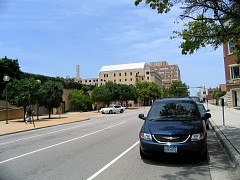 Margaret thought it would be a good idea to stop at the Oklahoma City Bombing Memorial. On this trip
we have previously stopped at the Alamo, site of a famous massacre, and Dealey Plaza, site of the
assassination of a U.S. President. Crystal remarked that, "We sure were stopping at a lot
of sad places". The "Tour of Tragedies" moniker was born. Here I am using for the first time
my 3.2 megapixel Cannon A70 digital camera. I like the quality of picture it produced. In the
picture just to the left, the memorial is in back of the vine-covered wall and up to the
building that looks like a next-door-neighbor building is missing. Indeed, the explosion
necessitated several nearby buildings to be razed.
Margaret thought it would be a good idea to stop at the Oklahoma City Bombing Memorial. On this trip
we have previously stopped at the Alamo, site of a famous massacre, and Dealey Plaza, site of the
assassination of a U.S. President. Crystal remarked that, "We sure were stopping at a lot
of sad places". The "Tour of Tragedies" moniker was born. Here I am using for the first time
my 3.2 megapixel Cannon A70 digital camera. I like the quality of picture it produced. In the
picture just to the left, the memorial is in back of the vine-covered wall and up to the
building that looks like a next-door-neighbor building is missing. Indeed, the explosion
necessitated several nearby buildings to be razed.
|
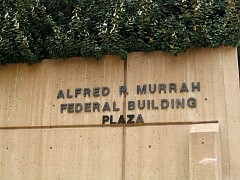 On April 19, 1995, in Oklahoma City, Oklahoma, a truck bomb exploded a two-ton bomb outside the Alfred E. Murrah
federal office
building, collapsing wall
and floors. 168 people were killed, including 19 children and 1 person who died in
rescue effort. Over 220 buildings sustained damage. Timothy McVeigh and Terry
Nichols later convicted in the anti-government plot to avenge the Branch Davidian
standoff in Waco, Texas, exactly two years earlier.
On April 19, 1995, in Oklahoma City, Oklahoma, a truck bomb exploded a two-ton bomb outside the Alfred E. Murrah
federal office
building, collapsing wall
and floors. 168 people were killed, including 19 children and 1 person who died in
rescue effort. Over 220 buildings sustained damage. Timothy McVeigh and Terry
Nichols later convicted in the anti-government plot to avenge the Branch Davidian
standoff in Waco, Texas, exactly two years earlier.
|
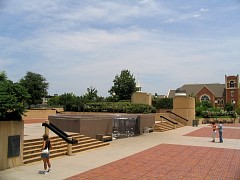
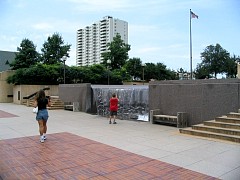
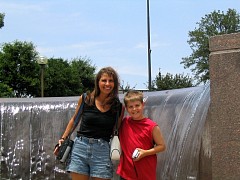
|
|
Above Margaret and Alec check out what was the back of the Alfred E. Murrah Federal
building. This waterfall
was part of the original building.
|
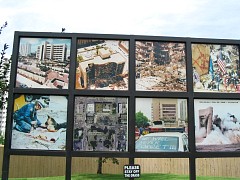
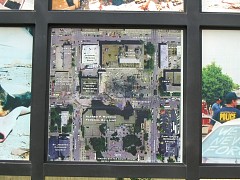
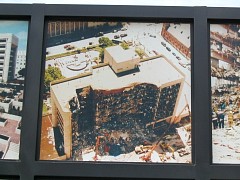
|
|
Here are pictures of panels at the memorial that show scenes of the aftermath. Enlarge
them to see them better.
|
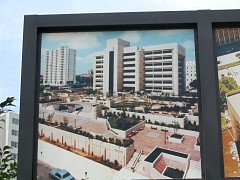
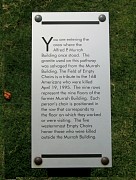
|
|
Ditto. Enlarge the picture above far left and look for the waterfall. That's the same
waterfall as above. That same picture shows the building from the back. The truck bomb
was driven along the street that passed in front of the building, where it was detonated.
|
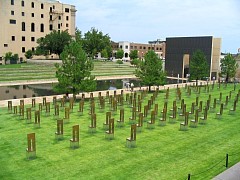
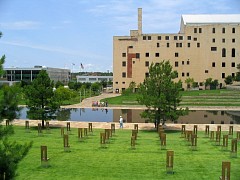
|
|
Here is one of the more important parts of the memorial. This grassy area is the
actual footprint of the original building. The reflecting pool covers where the
street that ran in front of the building ran. The rows chairs represent by floor of
the building the victims - each seat has a victim's name on it. There were 7 floors
and a basement, hence 8 rows of chairs.
|
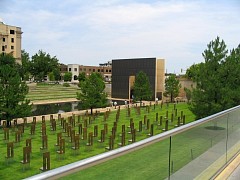


|



|
|
There are bookend-like walls that frame the water covered portion of the memorial that was
originally the street in front of the building. Visitors enter into the memorial by passing
through one of the two "Gates of
Time", monumental rectangular structures with a narrow slit of an entrance. The East gate
represents 9:01
and the West gate represents 9:03. The gates account for the
minutes before and after the bombing took
place. Once inside the gates, visitors enter into the minute of time in which the tragedy occured.
|
 "We come here to remember those who were killed, those who survived and
those changed forever. May all who leave here know the impact of violence.
May this memorial offer comfort, strength, peace, hope, and serenity."
"We come here to remember those who were killed, those who survived and
those changed forever. May all who leave here know the impact of violence.
May this memorial offer comfort, strength, peace, hope, and serenity."
|
 Alec's foot captured in an artistic manner. This shows how shallow the pool is.
Alec's foot captured in an artistic manner. This shows how shallow the pool is.
|
|
The Oklahoma Memorial further encourages the public to engage the events of the bombing within
both a museum and a center focused on terrorism. The museum is filled with artifacts
recovered from the bombing site. Many of the items that filled the Murrah building and belonged to the
victims were recovered and are now placed on display. In addition the museum offers visitors the
opportunity to hear a taping of the bombing, recovered from the minutes of a meeting that was
occurring
across the street, allowing visitors to relive the moment of horror and panic for the victims.
Items within the
museum offer the visitor a haunting picture of the ensuing destruction.
|



















